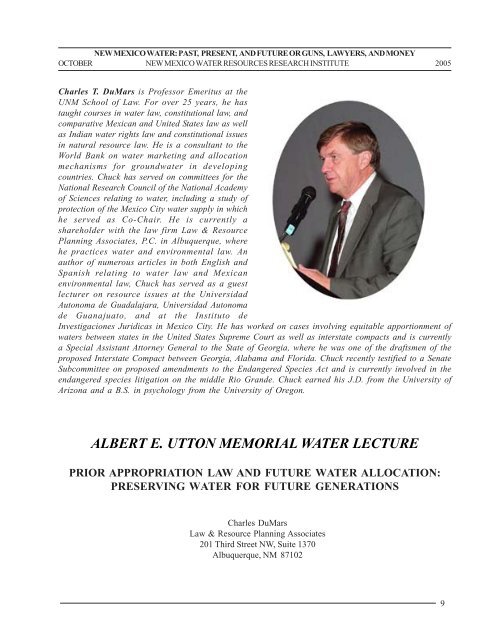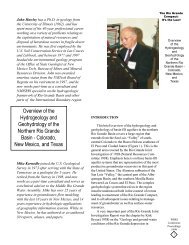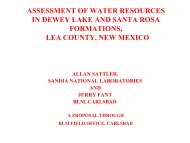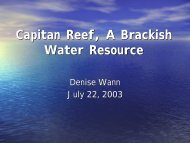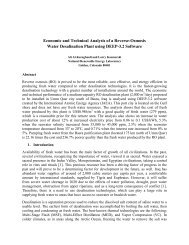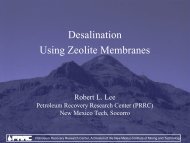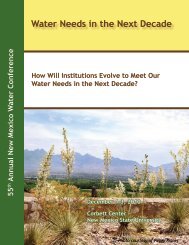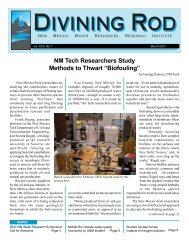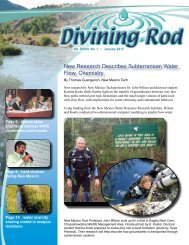Charles T. DuMars - Water Resources Research Institute
Charles T. DuMars - Water Resources Research Institute
Charles T. DuMars - Water Resources Research Institute
Create successful ePaper yourself
Turn your PDF publications into a flip-book with our unique Google optimized e-Paper software.
Prior Appropriation Law and Future <strong>Water</strong> Allocation: Preserving <strong>Water</strong> for Future Generations<br />
NEW MEXICO WATER: PAST, PRESENT, AND FUTURE OR GUNS, LAWYERS, AND MONEY<br />
OCTOBER NEW MEXICO WATER RESOURCES RESEARCH INSTITUTE 2005<br />
<strong>Charles</strong> T. <strong>DuMars</strong> is Professor Emeritus at the<br />
UNM School of Law. For over 25 years, he has<br />
taught courses in water law, constitutional law, and<br />
comparative Mexican and United States law as well<br />
as Indian water rights law and constitutional issues<br />
in natural resource law. He is a consultant to the<br />
World Bank on water marketing and allocation<br />
mechanisms for groundwater in developing<br />
countries. Chuck has served on committees for the<br />
National <strong>Research</strong> Council of the National Academy<br />
of Sciences relating to water, including a study of<br />
protection of the Mexico City water supply in which<br />
he served as Co-Chair. He is currently a<br />
shareholder with the law firm Law & Resource<br />
Planning Associates, P.C. in Albuquerque, where<br />
he practices water and environmental law. An<br />
author of numerous articles in both English and<br />
Spanish relating to water law and Mexican<br />
environmental law, Chuck has served as a guest<br />
lecturer on resource issues at the Universidad<br />
Autonoma de Guadalajara, Universidad Autonoma<br />
de Guanajuato, and at the Instituto de<br />
Investigaciones Juridicas in Mexico City. He has worked on cases involving equitable apportionment of<br />
waters between states in the United States Supreme Court as well as interstate compacts and is currently<br />
a Special Assistant Attorney General to the State of Georgia, where he was one of the draftsmen of the<br />
proposed Interstate Compact between Georgia, Alabama and Florida. Chuck recently testified to a Senate<br />
Subcommittee on proposed amendments to the Endangered Species Act and is currently involved in the<br />
endangered species litigation on the middle Rio Grande. Chuck earned his J.D. from the University of<br />
Arizona and a B.S. in psychology from the University of Oregon.<br />
ALBERT E. UTTON MEMORIAL WATER LECTURE<br />
PRIOR APPROPRIATION LAW AND FUTURE WATER ALLOCATION:<br />
PRESERVING WATER FOR FUTURE GENERATIONS<br />
<strong>Charles</strong> <strong>DuMars</strong><br />
Law & Resource Planning Associates<br />
201 Third Street NW, Suite 1370<br />
Albuquerque, NM 87102<br />
9
<strong>Charles</strong> <strong>DuMars</strong><br />
10<br />
A MEMORY OF AL UTTON, PERSUASION<br />
THROUGH CIVILITY AND HUMOR<br />
Thank you Tom for that introduction. It is indeed<br />
an honor to be here today to give the Utton Memorial<br />
Lecture. Before going into the substance of my talk, I<br />
want to say something about Al Utton and what he did<br />
for water law in New Mexico and all around the country<br />
and the world. He was a man who lived a commitment<br />
to a principle that I share: the principle that approaching<br />
people with fundamental honesty and civility under all<br />
circumstances, in the end, will yield positive results.<br />
An example of this comes to mind. Al once put together<br />
groups of experts in Belagio, Italy, to discuss<br />
transboundary water issues. The groups came from<br />
all over the world. Their goal was to have a discussion<br />
about optimal resolution of international and interstate<br />
water conflicts.<br />
At the opening session some participants from<br />
regions involved in a tacit cold war with one another<br />
We must have spent<br />
five minutes, maybe<br />
10, maybe 15, looking<br />
for the green flash and<br />
then Al says, “there it<br />
was!”<br />
refused to speak.<br />
Rather than yield to this<br />
behavior, he simply<br />
observed, “I understand<br />
the dissonance, but we<br />
can work through this.”<br />
It was an amazing<br />
phenomenon to see Al<br />
charm people into<br />
resolution of heated issues. I also observed him use<br />
these skills as chairman of the New Mexico Interstate<br />
Stream Commission and as Dean of the law school<br />
where he was a fellow colleague of mine. He wrote<br />
prolifically on a number of topics and always within<br />
the text of a conflict discussion he signaled a way out<br />
with a compromise making both sides better off.<br />
I remember in Belagio at that conference he turned<br />
to me as we walked into a room of angry faces and<br />
said “looks like this might be a hard audience.” There<br />
was a Palestinian water lawyer, an Israeli water lawyer,<br />
and a Russian. They had already had heated arguments<br />
and were not speaking. The sun was going down, and<br />
we were scheduled to begin our opening session. Bad<br />
feelings filled the room. Suddenly Al said “see that<br />
sunset over there” They all looked. “Just before the<br />
sun sinks into the ocean there is a moment of green, a<br />
green flash. You’ve got to look for it.” All turned to<br />
look. These enemies were all looking for the green<br />
flash. Al suggested he had heard it was caused by the<br />
weather. This led to a discussion of the weather in a<br />
border part of Russia where the rivers were facing<br />
drought. The representative from Israel looked<br />
unconvinced. We must have spent five minutes, maybe<br />
10, maybe 15, looking for the green flash and then Al<br />
says, “there it was!” They all said, “I didn’t see it.”<br />
And Al said, “I did,” and I said, “I saw it.” The topic<br />
turned slowly to the Jordon River and the death of the<br />
Black Sea and a number of topics that were very<br />
important to these people, all of which happened to be<br />
on the agenda for the meeting. I don’t believe there<br />
was a green flash in the sky, it was a flash of affective<br />
brilliance that defused borders and brought people<br />
together in a way few will ever duplicate today.<br />
It was really a loss for me when Al passed away.<br />
There was something the other day that I found that<br />
refreshed my recollection as to his incredible sense of<br />
humor. He did funny things, but not always so funny if<br />
you were the recipient. Because he was known around<br />
the world he would get a lot of different material on<br />
water law. The humor was that he would often like to<br />
“share.” One day when I arrived at my office at the<br />
law school, I looked on my desk and there were five,<br />
big, 5-inch thick notebooks. On them was a note written<br />
in Al’s large handwriting. He said “Chuck, I know in<br />
your work with the World Bank, this should prove very<br />
useful to you.” And on the caption of the notebooks it<br />
said: The <strong>Water</strong> Law of China. I thought this is<br />
incredible; this is great. Then, when I opened the first<br />
volume and looked, it was all in Chinese.<br />
Another example of Al’s humor was his behavior<br />
on airplanes. He would get on an airplane, turn to the<br />
flight magazine and make gifts to people of all the free<br />
offers from those planes. He would sign you up for<br />
free information on obscure acupuncture<br />
correspondence courses or information on strange get<br />
rich schemes. He would fill out the postcards with<br />
something like your name and the law school address.<br />
I once received three huge magazines on cosmetics<br />
and youth potions addressed to <strong>Charles</strong> Dinglemars,<br />
Professor Shyster Emeritus of lawyering. That was<br />
his sense of humor. That humor, that respect for others<br />
and his gift of charm made him a man I and many of<br />
you in the audience will miss today and continue to<br />
miss in the future.
Prior Appropriation Law and Future <strong>Water</strong> Allocation: Preserving <strong>Water</strong> for Future Generations<br />
THE PRIOR APPROPRIATION DOCTRINE,<br />
ITS BENEFICIARIES AND THE NEED FOR<br />
CHANGE<br />
The topic, prior appropriation, requires a little bit<br />
of definition. Most of you understand the basic<br />
definition, but we sometimes lose track of which<br />
members of society benefit the most from this doctrine.<br />
The prior appropriation doctrine of water law is of<br />
course that the first person to place water to beneficial<br />
use has the better right to use of that water. It exists in<br />
virtually all Western State constitutions. The principle<br />
is that if you beneficially use the resource, then you<br />
are entitled to have a better right in times of drought<br />
than someone else, that right being determined by the<br />
date you first applied the water to beneficial use.<br />
Who are the beneficiaries of that doctrine The<br />
beneficiaries in the Western United States can be<br />
loosely described as follows. Our economist friend will<br />
like this functional definition; the beneficiaries are the<br />
hardy risk-taking individuals who invest capital first by<br />
diverting the water and creating wealth. They are<br />
rewarded for their investment by being allowed the<br />
privilege of receiving the most water in times of<br />
shortage. There is, in effect, a bargain struck between<br />
those expending their capital to develop that resource<br />
and produce things and the state. For expenditure of<br />
their capital and producing wealth, these individual<br />
water right owners are given the best right in times of<br />
shortage.<br />
There are other beneficiaries. The courts<br />
throughout the nation recognize that Congress or mere<br />
aboriginal presence can offer benefit under that<br />
doctrine. Native American tribes are provided a priority<br />
date. Their quid pro quo for receiving an early priority<br />
date is not the actual use of the water but their mere<br />
presence of holders of an historical equity in the<br />
resource irrespective of use. If we think about it, if it<br />
were not for the prior appropriation doctrine<br />
establishing an early priority date, their aboriginal<br />
presence or the latter date of their treaty, or act of<br />
Congress creating a reservation, would be assigned a<br />
value of zero. The tribes would be forced to bargain in<br />
today’s society for a share of the resource in a way<br />
that under values their special value to the overall<br />
culture of this nation. Thus, the prior appropriation<br />
doctrine is vital in preserving their special place in our<br />
society.<br />
A third set of beneficiaries in New Mexico is the<br />
traditional Hispanic cultures of New Mexico, built<br />
around acequias. These are families whose use of<br />
water and physical presence predate the Treaty of<br />
Guadalupe Hidalgo and are the earliest documented<br />
non-Native American uses of water in this region.<br />
While the rights of land grant residents were<br />
dramatically watered down by the unfortunate<br />
Supreme Court cases interpreting the treaty of<br />
Guadalupe Hidalgo, the prior appropriative water rights<br />
of these groups survived<br />
those cases and give<br />
them a deserved special<br />
place as a function of<br />
their early use of the<br />
resource.<br />
Finally, the most<br />
important characteristic<br />
of the water resource<br />
under the prior appropriation<br />
doctrine is that<br />
the rights can be<br />
transferred, sold, or<br />
leased to others in times<br />
of shortage. The<br />
beneficiaries of this<br />
Finally, the most<br />
important<br />
characteristic of<br />
the water resource<br />
under the prior<br />
appropriation<br />
doctrine is that the<br />
rights can be<br />
transferred, sold or<br />
leased to others in<br />
times of shortage.<br />
characteristic are the entities that do not have sufficient<br />
water to survive a drought, but who can acquire rights<br />
from others in dry years and survive the weather<br />
extremes of our arid state. This ability to acquire rights<br />
from others through a market transaction is of course<br />
now loosely referred to as acquiring water rights in<br />
the water market.<br />
Prior appropriation doctrine works best if water<br />
can move from one set of users to another while<br />
maintaining the same priority date. In this example,<br />
economists would tell you that both the buyer and seller<br />
are made better off when such a sale or transfer takes<br />
place. Under this system, people with early priority<br />
dates will get the benefit of the capital value of that<br />
water right and the property it represents. This benefit<br />
could come in the form of a cash exchange to a private<br />
individual, a government loan or grant to build a water<br />
system for an Indian tribe in exchange for a sharing of<br />
shortages, or a program of forbearance whereby<br />
individuals are paid to forbear from use of their priority<br />
date and leave water in the stream for wildlife purposes.<br />
11
<strong>Charles</strong> <strong>DuMars</strong><br />
PRESSURES TOWARD THE POLITICAL<br />
ALLOCATION OF WATER<br />
The prior appropriation doctrine has currently come<br />
under fire from a lot of individuals. Who would you<br />
expect those to be It takes very little thought to surmise<br />
that the people<br />
...creative methods of<br />
voluntary adjustment of<br />
the right to use water in<br />
times of shortage are<br />
developing in many<br />
basins of New Mexico<br />
and this is a good thing.<br />
12<br />
challenging the<br />
doctrine would be<br />
the people who<br />
put the water<br />
rights to use most<br />
recently and have<br />
low priority dates<br />
or in the case of<br />
environmental<br />
groups seeking<br />
water for species, no priority date at all, or politicians<br />
who realize that the movement from a property based<br />
priority system to a politically allocated resource<br />
process would yield incredible political clout to the<br />
holder of that resource. As Robert Dahl wrote in his<br />
famous treaties “Who Governs,” politics is the<br />
allocation of resource among alternative political ends,<br />
and in New Mexico the most precious of all resources<br />
is water.<br />
Someone who has the low priority date or no<br />
priority date, will immediately conclude in times of<br />
drought, wait a minute, “this is a bad doctrine, this makes<br />
no sense, I should be able to – we need to allocate this<br />
resource politically. We need to look at society together<br />
as we reallocate it. What is this prior appropriation<br />
stuff Why should the date you first used water be<br />
relevant Society has changed.”<br />
It is easy to understand the frustrations of<br />
environmental groups who see other values in the<br />
resource, such as the needs of the riverine systems<br />
themselves. They voice very legitimate concerns.<br />
Likewise, and often more powerful on the political<br />
spectrum, you will find the major municipalities, urban<br />
interests, developers who need the resource to fuel<br />
the engines of capital promoted by growth.<br />
New users balk at the notion that somebody with<br />
a lower value use in economic terms or making up a<br />
minority portion of the population should control this<br />
resource. So there is a lot of opposition, a vague and<br />
unlikely alliance between New West environmentalists<br />
and major developers seeking to quench the thirst of<br />
growing Western megalopolis demand in places like<br />
Denver, Colorado. While they may fight each other<br />
for the resource, they both share the common<br />
perception that it should be allocated politically. This<br />
of course raises the adage you have be careful what<br />
you wish for.<br />
The opposition has grown so great, in the High<br />
Country News, in a book called The <strong>Water</strong> Handbook<br />
a very good personal friend of mine named <strong>Charles</strong><br />
Wilkinson pronounces the doctrine as dead. He took it<br />
upon himself to write the obituary for the prior<br />
appropriation doctrine. It reads:<br />
“As has been so widely reported, Mr. Prior<br />
Appropriation passed away in January of 1991<br />
at age 143. Prior was a grand man who led a<br />
grand life. By any standard he was one of the<br />
most influential people in the history of the<br />
American West. But sadly his day has<br />
passed.”<br />
Well that would be the view of the High Country<br />
News. It might be the view of those who believe they<br />
have the political clout to allocate the resource among<br />
subjective political ends, but I am happy to say this<br />
view does not really reflect the reality of today.<br />
The prior appropriation doctrine is alive and well<br />
because people cannot come up with a better idea.<br />
Even if they don’t agree with allocating water by<br />
priority, people don’t want to let it go. Most people<br />
don’t like the idea of relinquishing power completely<br />
to the “right thinking” government in Santa Fe who<br />
could reallocate it in the wisdom of philosopher kings.<br />
CONTEMPORARY SUPPORT FOR THE<br />
PRIOR APPROPRIATION DOCTRINE<br />
From what I can tell, the prior appropriation<br />
doctrine has a whole host of constituents who are<br />
supporting it today in spite of the fact it is under siege.<br />
The principles of prior appropriation are stronger than<br />
they have been for a long time because of the nature<br />
of the system of water allocation and because of the<br />
increase in scarcity. People are searching for efficient<br />
and fair ways to deal with shortage, and alternatives<br />
to rejection of this doctrine in favor of pure politics do<br />
not get far in the legislature in Santa Fe. However,<br />
creative methods of voluntary adjustment of the right<br />
to use water in times of shortage are developing in<br />
many basins of New Mexico and this is a good thing.<br />
The provisions for sharing of shortages in the San Juan<br />
Basin come to mind.
Prior Appropriation Law and Future <strong>Water</strong> Allocation: Preserving <strong>Water</strong> for Future Generations<br />
Em Hall is going to speak today on the origins of<br />
water law doctrine in New Mexico and how the<br />
doctrine varied historically by region within the State.<br />
And that will give us a very interesting discussion. The<br />
reason the prior appropriation doctrine has been so<br />
durable can be found in its evolution. Today’s times<br />
are not the only times when businesses have clashed<br />
with farmers, when politics have pressed private<br />
property.<br />
EVOLUTION OF THE DOCTRINE AND THE<br />
LESSONS APPLICABLE TO TODAY’S<br />
WORLD<br />
From the 1800s to the 1850s, there was really very<br />
little need for water law in the Eastern or the Western<br />
United States. In the Eastern United States there was<br />
little need for water law because there was more of it<br />
than they needed. Population centers had ample water<br />
supply. The riparian doctrine of water law in the East<br />
borrowed its principles from the common law of<br />
England. The common law simply holds that if<br />
somebody is bothering your water source, you can stop<br />
them as a nuisance if their actions are interfering with<br />
your reasonable use of this common resource.<br />
But the English common law never addressed in<br />
any sense the consequences of natural scarcity that<br />
exists in the West. Eastern streams did not dry up when<br />
a person upstream took all the water from a<br />
downstream user in an ephemeral stream leaving<br />
someone’s cattle to die.<br />
In the Western United States, there are a number<br />
of factors that led to the need for the development of<br />
this doctrine. We look at expanding populations in the<br />
new Western cities, but Western population expansion<br />
is as old as water scarcity in the West itself. It is<br />
interesting to look at the numbers on urbanization and<br />
how, from 1850 to 1900, the gold mining influences,<br />
the 49ers, that whole period of time from ‘49 to ‘72<br />
and up to the Great Depression of 1886, populations<br />
more than quadrupled. During that period of time, the<br />
West changed dramatically. The small streams with<br />
erratic flows, which had previously been quite<br />
adequate, were now found to be very inadequate<br />
because during times of scarcity there wasn’t enough<br />
to go around. There were federal proposals throughout<br />
the West at that time to encourage settlement. There<br />
were land programs that encouraged people if they<br />
could find a water source to homestead.<br />
A combination of land development policy, which<br />
encouraged settlement and the actual needs of certainty<br />
for those who had invested their capital in what turned<br />
out to be a “dry farm” in June and July, or a place mine<br />
that needed water called out for a water law that would<br />
work. The answer was prior appropriation, it was not<br />
and is not perfect but it provided a method to adapt to<br />
shortage that was acceptable.<br />
No one was going to invest in a mine or invest in<br />
agricultural development that used water or anything<br />
else in the West in the 1880s unless they had some<br />
real certainty for the<br />
people who were putting<br />
up the capital. The<br />
identical fights over the<br />
appropriateness of the<br />
doctrine appear in cases<br />
of the 1890s. No doubt,<br />
an obituary to the<br />
doctrine was written by<br />
a politician of the period<br />
The answer was<br />
prior appropriation,<br />
it was not and is not<br />
perfect but it<br />
provided a method<br />
to adapt to shortage<br />
that was acceptable.<br />
hoping to move water to his constituents as a means<br />
of staying in office.<br />
But, there was insufficient capital in many cases<br />
to take advantage of the hydrographs of the regions.<br />
The Reclamation Act of 1902 recognized that if you<br />
were going to harness Western rivers, you needed to<br />
have reservoirs. Erratic flows and huge variability<br />
required that if you were going to produce with water<br />
you needed to be able to store it and release it at a rate<br />
which would be useful during the irrigation season and<br />
you also needed to store it for flood protection.<br />
The Reclamation Act of 1902 paid for and<br />
encouraged infrastructure; the Desert Lands Act of<br />
1877 vested water rights in private individuals. Both<br />
encouraged development and rewarded people for<br />
coming out and using water resources of the West.<br />
These laws were bottomed in the notion that there<br />
was a separate set of water needs and water right<br />
needs in the West distinguishable from those in the<br />
Eastern United States.<br />
There is no doubt that some of the choices of<br />
federal subsidies for projects with negative cost/benefit<br />
ratios and the absence of the knowledge of the effects<br />
of some of these reservoirs and projects were short<br />
sighted. But seen through the lens of the engineers of<br />
the time, those choices generated wealth for those<br />
seeking to better their lot and willing to farm to make<br />
their lives better. Making the desert green may have<br />
of course been a double entendre that at times resulted<br />
13
<strong>Charles</strong> <strong>DuMars</strong><br />
in skewed results, but the effect on water law doctrine<br />
is unmistakable and the issues were not so different<br />
then from what they are today. The interesting part to<br />
me was how both the Eastern and Western systems<br />
flourished, and yet lawyers trained in the Riparian<br />
Doctrine almost never communicated with lawyers<br />
born and bred from the Prior Appropriation doctrine.<br />
At least from 1900 through 1930 a review of the legal<br />
literature yields virtually no articles comparing the<br />
doctrines.<br />
THE UNIQUE NATURE OF THE DOCTRINE<br />
AND WHAT THE FUTURE MAY HOLD<br />
So if my topic today is prior appropriation doctrine,<br />
where are we now and where are we going in the<br />
future, I thought it would be really useful to do some<br />
research and figure out why it is that the two separate<br />
doctrines going on at the same time in the United States<br />
evolved so separately and essentially failed to cross<br />
pollinate to yield changes in the doctrine.<br />
No other law is so region based. You look at the<br />
law around the country; property law is essentially the<br />
same all over the United States. Personal property law<br />
is a little different among regions, but not really very<br />
different. Whether the property law is private or public<br />
sector, private lands or public lands in the West, the<br />
law is essentially the same, but water law from East to<br />
West is night and day and the twain never met<br />
historically.<br />
So I began to look at the physical characteristics<br />
of the resource itself. What I have learned during my<br />
30-year career (John Hernandez knows what I am<br />
talking about) is that water, the substance water, if<br />
you try to really understand it and for lawyers who<br />
have to teach water law in class and seek doctrinal<br />
clarity, water will drive you insane.<br />
<strong>Water</strong> is both a public and a private resource. It<br />
comes in rates and amounts and qualities that vary;<br />
they are not constant so one constant set of rules is<br />
extremely difficult. When I say public/private resource,<br />
I mean that for the environmental group it is movement<br />
through space that generates a public value, but for<br />
the farmer who diverts it in acre-feet to grow crops,<br />
owning it is a very private act.<br />
The simultaneous dual characteristic of the<br />
resource brings to mind an analogy to physics. I<br />
remember when I took physics; I was perplexed by<br />
attempts to define sunlight. What is sunlight Is it a<br />
wave; that is one of its characteristics. Or is it a<br />
particle It behaves like a wave and bends and adjusts<br />
through materials, but it can be measured in chunks or<br />
units. I told my professor it cannot be both, but he<br />
simply said yes it can. He pointed out for any scientific<br />
explanation to work, it had to be both because it needs<br />
both of those characteristics to perform its functions.<br />
<strong>Water</strong> is the same as sunlight. It changes form; it<br />
provides benefits, and to be “water,” it must be multiple<br />
things to multiple peoples. <strong>Water</strong> is a public good<br />
because we need it to be members of the public at<br />
large: it supports flora and fauna, it is part of a cycle<br />
that no one controls, it can be used in multiple ways, it<br />
can change form or substance. The fact it freezes from<br />
the top down is the basis for modern civilization; if it<br />
didn’t do that we wouldn’t have the civilization we<br />
have now. If water froze from the bottom up the<br />
Northern hemisphere would be a wasteland. <strong>Water</strong> in<br />
streams creates wonderful insulation; it is the best<br />
universal solvent. Yet it can be sold in bottles that I am<br />
embarrassed to say I bought this morning for too damn<br />
much money as the economists would say, but it was<br />
too far to walk to the Rio Grande from here in Las<br />
Cruces, and farmers are using it to grow pecans, which<br />
I will also pay too much for.<br />
<strong>Water</strong> can be arranged in chunks as ice; it can be<br />
allocated for irrigation and when it comes back as return<br />
flows it can be used again, but if its leaches out too<br />
much salt, it creates pollution. But if you don’t have<br />
return flows for others to use, you may reduce stream<br />
flow and further endanger species. It is indeed a<br />
puzzlement.<br />
GOOD WATER LAWYERS ARE BI-POLAR<br />
I have decided that in order to understand the<br />
resource water and to be a water lawyer like the ones<br />
I see in this audience, you have to be essentially bipolar.<br />
Looking at my friends over the years, that’s kind<br />
of who they are. They can stand this unending unclarity.<br />
For those of us who have learned as academics<br />
to stop worrying and embrace cognitive dissonance<br />
we survive. But as populations expand and scarcity<br />
increases, considering that water is the most vital<br />
resource, there is an incredibly significant need to<br />
resolve the tension between those who want to let the<br />
market allocate the resource and those who would treat<br />
it as an exclusively political resource. How the gap<br />
between those two perspectives is going to be bridged<br />
14
Prior Appropriation Law and Future <strong>Water</strong> Allocation: Preserving <strong>Water</strong> for Future Generations<br />
is incredibly significant for the future of society and, in<br />
my view, is the most important question.<br />
THE MORE THINGS HAVE CHANGED, THE<br />
MORE THEY HAVE STAYED THE SAME<br />
Now that I am part of a private practice I can<br />
afford law clerks. So I told my clerk to find the leading<br />
historical article on water law. I need to know<br />
something about the evolution of water law and how<br />
this debate was addressed in years past. He said, okay<br />
I found an article for you for Professor. I said, don’t<br />
call me Professor, I’m a lawyer now; I reminded him<br />
that I had never lost a case in class. Of course, I lost<br />
a few since I left the law school, but in class I never<br />
lost a case.<br />
The article he found is entitled “Fifty Years of <strong>Water</strong><br />
Law.” It can be found in the highly prestigious Harvard<br />
Law Review. See 50 Harvard L. Rev. 252 (1936). I<br />
said, how did I miss that article I have read every<br />
article in the last fifty years. He pointed out that the<br />
date of the article was 1936. Hmmm, I said this might<br />
be interesting. Surely things were different then; surely<br />
the debate was more rational in 1936 before society<br />
became so fragmented and complex. The article is<br />
written by Samuel C. Wiel who is the author of treaties<br />
and a very famous author in the area of water law.<br />
The date, fifty years, celebrated the first fifty years of<br />
publication of the Harvard Law Review prior to 1936.<br />
The amazing thing is that his concerns and his<br />
perspective in 1936 as to what is and what needs to<br />
change could be written today. It was fascinating to<br />
read the article.<br />
He talks about the Lux v. Hagen case made<br />
famous in California - a case where the biggest cattle<br />
baron in the country had flood water rights, and<br />
upstream they were trying to build an irrigation project<br />
and how even the Supreme Court was afraid of getting<br />
its ass shot off. But after 200 pages, finally gave up<br />
and said, we don’t understand it and let both doctrines<br />
exist simultaneously in California. The debate there<br />
could have been the same debate that is ongoing in the<br />
middle Rio Grande over the needs of farmers and the<br />
needs of the endangered Rio Grande Silvery minnow.<br />
You have to be bi-polar to practice water law and learn<br />
to accept the perpetual tension created by the multiple<br />
characteristics of the resource.<br />
But here is the part I found interesting. He says<br />
this: “In all events and just in uses that are now on<br />
hand, it [the transfer of water rights] seems to be getting<br />
more attention than additional development.” He<br />
concluded that in 1936, from his perspective, the system<br />
is fully appropriated so it is the water transfer that is<br />
where the action is in terms of the law and moderating<br />
principles of prior appropriation with principles of<br />
reasonable use. He further notes, “The riparian doctrine<br />
seems to be outstripping use of rights by priority of<br />
appropriation in general esteem and will carry the day.”<br />
So in 1936, Professor Wiel predicted that certainly the<br />
rule of reasonable use<br />
of riparian doctrine<br />
will take over and<br />
prior appropriation<br />
will disappear. That<br />
shows what bad<br />
predictors we law<br />
professors are. He did<br />
say something very<br />
entertaining about<br />
water lawyers that is<br />
certainly true today.<br />
He said this, “very<br />
evidently the 50 years<br />
of water law have<br />
been of divergence<br />
and conflict” (that’s<br />
true). “Review of<br />
He [Samuel C. Wiel]<br />
concluded that in 1936,<br />
from his perspective,<br />
the system is fully<br />
appropriated so it is<br />
the water transfer that<br />
is where the action is in<br />
terms of the law and<br />
moderating principles<br />
of prior appropriation<br />
with principles of<br />
reasonable use.<br />
them [the leading cases] could easily be jargon often<br />
among different rulings of the same court.” Hmm,<br />
courts contradict themselves in water law Here<br />
comes a slap at me as a water law professor, which I<br />
resent but which is undoubtedly true of all of us in this<br />
field. He says, “the ancients express the mysticism of<br />
restraint or sprain by a spirit of water to whom a temple<br />
was erected. Modern water law practice is apt to<br />
express it by mystical devotion to linguistic charm.”<br />
<strong>Water</strong> law as mystical devotion to linguistic charm,<br />
well maybe, but not completely. I like to hope there is<br />
some sound policy and adaptation of law to changing<br />
times.<br />
The next document I came across was one written<br />
by Joaquin Lopez, a good friend of mine who is one of<br />
the most famous water lawyers in Argentina. Although<br />
he wrote it in 1960, it was republished in the University<br />
of the Republic of Argentina Journal and entitled,<br />
“Adjusting to the New <strong>Water</strong> Law Areas of Conflict<br />
1960 in Argentina.” This is my translation so who<br />
knows what it really says. He states:<br />
15
<strong>Charles</strong> <strong>DuMars</strong><br />
16<br />
“The constitution of Argentina contains two<br />
vital and conflicting provisions, the power to<br />
regulate and legislate regarding water for the<br />
good of the general welfare and the obligation<br />
to protect the private property rights of water<br />
for each user.”<br />
Sounds familiar, it seems that within the Argentine<br />
water law they were trying to regulate and allocate<br />
the resource because of changing politics at the same<br />
time they were calling out for protection of the private<br />
property rights under the Argentine constitution. It’s<br />
the same debate that Professor Wiel discussed in 1936,<br />
the same debate that came up during the hearings on<br />
the Reclamation Act. And it is the same argument that<br />
was raised in the United States Supreme Court as<br />
recently as last year.<br />
TWO FOOLISH ACADEMICS TRY TO<br />
PREDICT THE FUTURE OF THE WATER<br />
MARKET IN THE 1970’S<br />
In 1977, two very foolhardy people, three actually,<br />
set out to analyze water markets in New Mexico to<br />
determine whether they actually existed, whether water<br />
was a private commodity traded in the market place,<br />
and if it was what its price might be in the future. The<br />
book is called Forecasting Future Market Values of<br />
<strong>Water</strong> Rights in New Mexico, by Brown,<br />
Khoshakhlagh, and <strong>DuMars</strong>.<br />
We said, “We’re smart people; we can go out, we<br />
can analyze prices, we can tell you right now, in 1977,<br />
what a water right is going to cost in 1990 using<br />
economic projections, and we can predict after<br />
evaluating the circumstance and make some wise<br />
observations.” Before I get to the quote from what<br />
we concluded, let me tell you what our observations<br />
were back then.<br />
The actual prices: in 1975 a water right in the Rio<br />
Grande Valley sold for $502 per acre-foot. Okay, that’s<br />
the bottom line. We then got together and said suppose<br />
you ran through every damn escalator you can think<br />
of, suppose you then fudged a little and don’t want to<br />
be embarrassed by undervaluing the escalation of<br />
prices for the resource: what would we come up with<br />
for predictions in 1990 for the value of an acre-foot<br />
consumptive use of water Oh hell, let’s go with it as<br />
wild as it gets; let’s go with $1,100 an acre-foot. $2,250<br />
an acre-foot. $2,500 if you really speculate. $3,200<br />
was tops. Boy was that insanely high we thought and<br />
embarrassed and when it came out. Some people<br />
laughed and said that makes no sense, there is nothing<br />
in the literature which suggests that is true professor.<br />
Well what do I know The last transaction I dealt<br />
with in the Rio Grande, the people showed up at closing,<br />
they had sold it for $6,500, demanded $2,000 more,<br />
and the person wrote a check immediately for $8,500<br />
an acre-foot consumptive use. <strong>Water</strong> rights are now<br />
selling for $10,000 an acre-foot.<br />
But a rapid price increase tells you it is thriving in<br />
the market place as a commodity, but it does not<br />
necessarily tell you whether society at large is getting<br />
the value from this complex resource that it should.<br />
Lee Brown and I had a basic concern then; I talked to<br />
him the other day, and our concern was that not all the<br />
values reflected in water are a function of its true<br />
market price in terms of what it would bring if you sell<br />
it. The key is to ensure those values are protected in<br />
the market place, but not allow complete displacement<br />
of the market through rigid political intervention.<br />
<strong>Water</strong> markets in New Mexico face the inevitable<br />
unclarity required to accommodate non-economic<br />
values in water; there is also a kind of frightening, lack<br />
of information as to policy as to transferability and the<br />
extent of the commodity itself. Policies can simply<br />
appear. What was once thought to be a characteristic<br />
of the right can suddenly be modified by policy without<br />
public input. This is not a good thing. If you don’t have<br />
good market information you cannot value the resource<br />
properly for public or private purposes. We concluded<br />
the following in 1977:<br />
“the overriding need with the region (the<br />
Albuquerque region) is for increased flexibility<br />
as water consumption as it inexorably<br />
approaches its physical limits. It is easier to<br />
take steps now to begin the slow evolution<br />
towards this increased flexibility than it will be<br />
to wait until a rigid humanly constructed barrier<br />
is breached.”<br />
By rigid humanly constructed barrier, we meant<br />
artificial, politically motivated actions, in effect the social<br />
engineering of a resource, because they are so<br />
unpredictable that individuals cannot make wise choices<br />
how to acquire or conserve the resource.
Prior Appropriation Law and Future <strong>Water</strong> Allocation: Preserving <strong>Water</strong> for Future Generations<br />
THE GOVERNOR’S WATER LAW STUDY<br />
COMMITTEE RECOMMENDS CREATION<br />
OF A GROUND WATER RESERVE FOR<br />
FUTURE GENERATIONS<br />
In 1986 Governor Anaya, noting that virtually all<br />
of the water in New Mexico was nearing full<br />
appropriation and that other states coveted the<br />
resource, created the <strong>Water</strong> Law Study Committee to<br />
evaluate and answer four questions: How much water<br />
is there If there is not enough, what are we going to<br />
do about it And what is the interstate demand for that<br />
resource To what degree can we assure that we have<br />
that resource stay in the state of New Mexico We<br />
found in that study, and I think it is quite accurate, that<br />
there are large amounts of unappropriated ground water<br />
in New Mexico that are currently unavailable by<br />
existing criteria, appropriation criteria. We calculated<br />
the amount with the help of the State Engineer’s Office.<br />
There remained 80 million acre-feet unappropriated<br />
of potable ground water, much of it in the southwestern<br />
part of the state, much of it near planned growth areas<br />
in Mexico and some of it near Tucson.<br />
We also correctly found that these water resources<br />
are vital for the future of New Mexico. Pure market<br />
solutions might not work to preserve those resources<br />
for New Mexico’s future. We were very concerned<br />
then and we suggested, and I still can suggest, in my<br />
view, with respect to that part of the resource, it is<br />
vital to come up with some method of strategic ground<br />
water reserve to evaluate those resources, calculate<br />
our future needs and get a real handle on that. One of<br />
my suggestions was to really focus on that<br />
unappropriated ground water, admit it is there, not deny<br />
it is there for political reasons or otherwise, and make<br />
sure that it is available for future New Mexicans. But<br />
that is really not a prior appropriation issue per se, it is<br />
a water planning issue. We concluded that the public<br />
nature of the resource meant that we should declare<br />
the conservation of that water in storage a beneficial<br />
use within the meaning of the prior appropriation<br />
doctrine and that it should remain forever for New<br />
Mexicans.<br />
The <strong>Water</strong> Law Study Committee consisted of<br />
Robert B. Anderson (Robert O. Anderson’s son),<br />
Gerald Thomas from New Mexico State, Les Davis<br />
of the CS Ranch, Carol Christiano and myself. Tom<br />
Bahr was involved; Al Utton was involved, along with<br />
a number of others who were very, very useful.<br />
What we were concerned about were the effects<br />
on the water market that was inexorably moving toward<br />
expansion where price reflects scarcity in agriculture<br />
and where agriculture cannot compete. And the loss<br />
of agriculture to New Mexico would be devastating<br />
culturally and economically in many sectors. I now<br />
must confess my bias, my background. I grew up on a<br />
ranch. That’s what I know; that’s what I’ve done all<br />
my life. But the reality is, of course, that there is a<br />
water market that<br />
will evolve, needs to<br />
evolve, and there<br />
needs to be clarity<br />
in that market, and<br />
those water users<br />
who cannot compete<br />
must adapt and<br />
adjust. But a state<br />
consisting only of<br />
condo dwellers<br />
importing water to<br />
gravel backyards<br />
was not then and is<br />
One of my suggestions<br />
was to really focus on<br />
that unappropriated<br />
ground water, admit it is<br />
there, not deny it is there<br />
for political reasons or<br />
otherwise, and make<br />
sure that it is available<br />
for future New<br />
Mexicans.<br />
not now my dream for New Mexico.<br />
What the Committee concluded then in 1986 was<br />
that agriculture may not be able to compete with<br />
municipalities and other industries for water from a<br />
strictly economic viewpoint yet the long-term interests<br />
of the state may best be served by sustaining the<br />
healthy agricultural industry in selected areas. Because<br />
the state values its best agricultural land, its unique<br />
cultures, and other fundamental resources such as the<br />
bosques and wildlife, the state may have to acquire<br />
water rights in the market place to keep them, that is<br />
to say hold them in trust to ensure that it is possible to<br />
sustain agriculture. This water trust coupled with<br />
various kinds of research and support could sustain<br />
this special culture. I am happy to say that now in the<br />
legislature years later precisely these kinds of water<br />
trusts are being created for multiple purposes.<br />
We also included on the cover of our report the<br />
following: “let it not be said in one or more decades<br />
hence that the present society knowing the foreseeable<br />
conditions neglected to confront them in all possible<br />
ways.” That was the challenge of New Mexico in 1986.<br />
That is the challenge today.<br />
17
<strong>Charles</strong> <strong>DuMars</strong><br />
POSITIVE NEW DEVELOPMENTS BODE<br />
WELL FOR THE FUTURE<br />
A number of things have happened since that study<br />
- some good, some not so good. I think one of the best<br />
things that has happened is that the Interstate Stream<br />
Commission has evolved into a responsible<br />
representative political body. Our study recommended<br />
that the Interstate Stream Commission, which is a<br />
representative body throughout the state, move forward<br />
and play a leadership role in promoting and developing<br />
water policy.<br />
That leadership has stepped forward. Under new<br />
leadership it has sponsored legislation, which I think is<br />
really helpful with the idea of acquiring water, supporting<br />
rural infrastructure, enforcing interstate compacts, and<br />
serving as a source of useful information.<br />
The other thing that has happened is that the<br />
legislature passed the legislation recommending support<br />
of regional water planning. Regional water planning<br />
has done a lot of really useful things for us and it has<br />
involved the education level of individuals who are out<br />
there working in water, but there is something that is<br />
occurring now that I think addresses the future of the<br />
prior appropriation doctrine.<br />
The purest prior<br />
appropriation doctrine<br />
has never really<br />
existed much in New<br />
Mexico in the middle<br />
and lower Rio Grande<br />
valleys, and in some<br />
ways this has been a<br />
good thing.<br />
18<br />
We are not really in<br />
that bad of shape. The<br />
purest prior appropriation<br />
doctrine has<br />
never really existed<br />
much in New Mexico<br />
in the middle and<br />
lower Rio Grande<br />
valleys, and in some<br />
ways this has been a<br />
good thing. Certainly<br />
the Native Americans<br />
are entitled to enforce<br />
priorities, but conservancy districts and irrigation<br />
districts buffer the effect of that doctrine by requiring<br />
a sharing of shortages.<br />
For example, if you have a group of 10,000<br />
farmers, each of whom has a different priority date,<br />
and you’re trying to enforce priorities down to the<br />
minute as to who diverted first, it is not going to work.<br />
So what has happened in the middle and lower Rio<br />
Grande valleys and has happened in most Western<br />
states, there have developed local institutions that have<br />
banned together. They were created as political<br />
subdivisions with elected boards to allow at the<br />
grassroots level a method to allocate water in times of<br />
drought by sharing shortages. In the Middle Rio Grande<br />
Conservancy District, for example, when there is a<br />
short year, everybody shares shortages. If the Board<br />
is unfair, it gets voted out of office. This local control<br />
can be critical.<br />
THE CHALLENGE WILL BE TO STRIKE A<br />
BALANCE BETWEEN PURE ECONOMIC<br />
ALLOCATION AND SELF INTERESTED<br />
POLITICAL MANIPULATION OF THE<br />
RESOURCE<br />
There is a principle that I have witnessed<br />
everywhere I have worked, and I have worked in quite<br />
a few different places. That principle is the more scarce<br />
the resource, the greater the tendency to take it out of<br />
private hands and to place it at the mercy of raw<br />
political power. It is the nature of things; it is the nature<br />
of politics. I remember interviewing once the head of<br />
the National <strong>Water</strong> Commission in Mexico. Article 17<br />
of the Constitution allocates all of the resources as a<br />
political good. They allocate it to the regions based<br />
upon their alliances with the various political parties.<br />
In the interview, he said to me something that I will not<br />
forget. He said, “El poder debe ser absoluto.” He<br />
said, “The power of my job must be absolute.” To obtain<br />
the power to allocate water to wield it pursuant to one’s<br />
own political instincts is natural, but is dangerous. Yet,<br />
as I said earlier, there is a critical tension. Back to my<br />
sun metaphor, there is a tension on the one hand,<br />
between the desire to let the economy allocate the<br />
resource by price and forcing other users to react to<br />
the scarcity by adjusting to the marketplace by<br />
conserving. And, there is the political desire to subsidize,<br />
to control the price, by mandated alteration of the<br />
cropping patterns. There is a desire to have that “poder<br />
que es absoluto.”<br />
Now in New Mexico, we are facing those tensions<br />
in this state more and more every year. The test will<br />
be to regulate the market but not manage it to the point<br />
of political manipulation. You have the Office of the<br />
State Engineer; that Office faces an incredible<br />
challenge. I can say from my own personal experience<br />
that the local offices of the State Engineer that I deal<br />
with are wonderful organizations at the grassroots level<br />
that do their best to help people cooperate. Yet at the<br />
top government levels, impatience with the water<br />
markets can bring about mandated changes based upon
Prior Appropriation Law and Future <strong>Water</strong> Allocation: Preserving <strong>Water</strong> for Future Generations<br />
politics of value judgments beyond those of requiring<br />
conservation and the dissemination of information.<br />
The economist who preceded me in this lecture<br />
insists that there is a tremendous amount of disposable<br />
income in today’s society more than ever in history. If<br />
the prior appropriation doctrine is to work, though, we<br />
have to let the institutions, the users, the consumers,<br />
those people with all that money make the rational<br />
choices he talks about. He argued that an educated<br />
society buys products that promote and protect the<br />
environment, that using the least water preserves the<br />
most wetlands. I sincerely hope he is right. If we in<br />
fact have all of this disposable income out there, and if<br />
there’s the ability to buy smart water - water obtained<br />
through conservation, and if we can grow the specialty<br />
crops without excessive pollution, and if conservation<br />
can pay, and I think it can, then the people who use the<br />
resource make the choice that blends the public and<br />
private values of the resource.<br />
WATER RESOURCE AVAILABILITY, ITS<br />
VALUE IN PRODUCTION AND IN SUPPORT<br />
OF THE ENVIRONMENT MUST BE MADE<br />
COMPLETELY TRANSPARENT IN EVERY<br />
FORUM<br />
The prior appropriation doctrine is not going away.<br />
Anglos, Hispanics, Native Americans, acequias, and<br />
the conservancy and irrigation districts with their early<br />
priority water rights are not going to give up those rights.<br />
They cannot be taken because someone filed a lawsuit<br />
saying that the Rio Grande silvery minnow should get<br />
the water in times of scarcity rather than farmers.<br />
Society will not tolerate that result. The system is going<br />
to stay in place. But society will also not tolerate a life<br />
space without farms, without wetlands, and without a<br />
diverse habitat for its people and its creatures.<br />
The first thing every economist will tell you is that<br />
you need good market information. You need to know<br />
about the resource. Where can you go today to find<br />
out anything about the value of water rights in New<br />
Mexico Bill Turner knows, and he isn’t telling. There<br />
is no place to get the information about the value of<br />
the good. There is no place to go. There is no common<br />
source of information about this commodity.<br />
In contrast, there is a great deal of information on<br />
the environmental side. They are terrific, and they do<br />
a great job. While their view of the data may be skewed<br />
from some perspectives, they are there. They know<br />
the resource they want to protect; they are protecting<br />
it, and it is vital that they do so. They will tell you how<br />
much water the silvery minnow needs, what is going<br />
to happen, and the consequences of not protecting it.<br />
But on the market private sector side, from the production<br />
value of<br />
...there is a tension on the<br />
one hand, between the<br />
desire to let the economy<br />
allocate the resource by<br />
price and forcing other<br />
users to react to the scarcity<br />
by adjusting to the<br />
marketplace by conserving.<br />
And, there is the political<br />
desire to subsidize, to<br />
control the price by<br />
mandated alteration of the<br />
cropping patterns.<br />
water, there is<br />
no common<br />
place to find out<br />
the value of<br />
water in production,<br />
its<br />
overall supply<br />
and how to<br />
obtain it. This<br />
must improve<br />
for the system<br />
to function in<br />
the future.<br />
Not only is<br />
the absence of<br />
good information<br />
a serious<br />
problem for good water policy, another thing that the<br />
prior appropriation doctrine of water markets cannot<br />
stand is policy surprises. If there is to be a change in<br />
the policy about whether you can use ground water to<br />
offset water rights in certain communities and other<br />
wells, it needs to be a public process where everybody<br />
goes. If rules for conservation change, the changes<br />
must be made public through a public process. The<br />
problem is one of scale. If the prior appropriation<br />
doctrine is to work, the development of process will be<br />
vital. The system works well within a small acequia<br />
where everybody knows everybody, and you know if<br />
they are not digging out their part of the ditch or are<br />
using too much water.<br />
When you have 10,000 farmers or you have the<br />
City of Albuquerque paying a lot for San Juan-Chama<br />
water, and you have a decision made by a court that<br />
will affect investments already made, then without full<br />
public process, by the recognition of new rights in water<br />
not heretofore understood, the result can be chaos.<br />
We need to do it better than this.<br />
The third thing we need to do is we need to take a<br />
real close look at the way in which we clarify the<br />
19
<strong>Charles</strong> <strong>DuMars</strong><br />
Not only is the absence<br />
of good information a<br />
serious problem for<br />
good water policy,<br />
another thing that the<br />
prior appropriation<br />
doctrine of water<br />
markets cannot stand<br />
is policy surprises.<br />
commodity itself through the adjudication process.<br />
Thank goodness Judge Valentine is chairing a<br />
committee of brave souls appointed by the New<br />
Mexico Supreme Court trying to move the adjudication<br />
process into warp speed and clarify the ad-judications<br />
rules to see if we cannot expedite that process.<br />
There are<br />
some really exciting<br />
things<br />
going on there. It<br />
is going to take a<br />
lot of resources<br />
from the legislature<br />
to make it<br />
work. But if we<br />
can work to get<br />
those rules<br />
clarified, and we<br />
can speed up the<br />
adjudication<br />
process to make it work even better, I think the prior<br />
appropriation doctrine will work. It must work.<br />
My prediction is that water for the future will be a<br />
much better understood resource; I’d say that we need<br />
to start now, immediately, to produce more<br />
transparency as to the value of water, not just<br />
economics, but also aesthetics. This is what the<br />
environmentalists do.<br />
We need to illustrate the value of agriculture better,<br />
the value of production, if we want it to remain in<br />
agriculture. Finally, we need to try to reduce conflict<br />
from yelling and litigation to just talking and educating.<br />
I look around this group and think you cannot find a<br />
nicer group of people, with a few exceptions, who mean<br />
well. The water bar of lawyers is a wonderful group<br />
of people to be around. Those who work in this region<br />
are wonderful to be around - bipolar so they can stand<br />
to work with this complex resource, but wonderful<br />
people.<br />
CONCLUSION<br />
And if we can get everyone looking for Al Utton’s<br />
little spot of green at sunset, and all get on the same<br />
page, and make available in every forum the information<br />
about the water resource, the markets, the water law,<br />
and the steps for rational reallocation, I believe we<br />
have a tremendous future under the prior appropriation<br />
doctrine.<br />
Thank you.<br />
20


